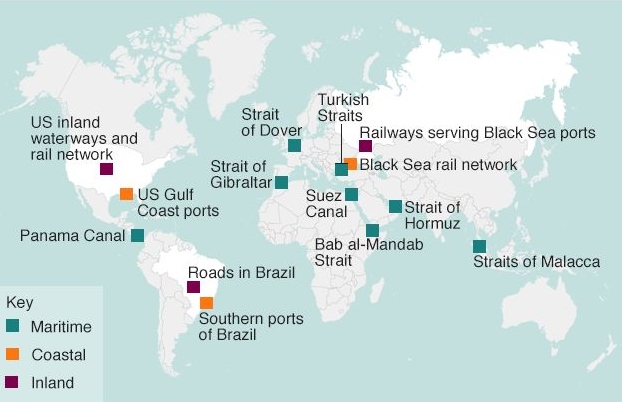Choke Points
December 1, 2017 | Expert Insights

The growing importance of global trade in agricultural commodities has increased the risks of disruption at key transport 'chokepoints', potentially triggering food price surges..
Chokepoints are important as they increase the vulnerability of supply chains to disruption, or rather, instances where a chokepoint has a high amount of trade means that disruptions are likely to be more severe. They are also important because they funnel a huge share of the global food supply in the most basic grains – grains that supply two-thirds of the world’s harvested calories.
Infrastructure at the chokepoints is often old and would struggle to cope with natural disasters, which are expected to grow in frequency as the planet warms.
- Three-quarters of Japan's maize and wheat imports pass through the Panama Canal, which is just 300m (984th) wide.
- Just over a third of grain imports for the Middle East and North Africa pass through the Turkish Straits, with no alternative maritime route available.
- More than 25% of soybean exports are shipped across the Straits of Malacca.
- Roads in Brazil, the world's largest exporter of soybean, are at risk of flooding and landslides because of heavy rains.
- US Gulf Coast ports face storm surges boosted by rising seas.
- Gulf Co-operation Council countries rely on grain from the Black Sea region that is transported via the choke-points of the Russian and Ukrainian railways/ports, the Turkish Straits and the Suez Canal.
Threats to Food Security and the Global Food Trade
If climate change results in both increased import dependence for some producers, in tandem with a greater reliance on other regions, reliance on a specific chokepoint may increase significantly.
Low income countries will be the hardest hit by droughts and extreme weather - causing a rise in import dependance of basic food supply.
Food security also faces many threats, such as weakening governance structures, the potential for trade wars, growing populations and security concerns. These threats can manifest themselves at chokepoints which leverage their impact and magnify their consequences up and down the supply chain.
Highly vulnerable countries
The regions which are likely to exhibit both population increases and severe climate change impacts are at the greatest risk, such as northern and sub-Saharan Africa (Uganda, Ethiopia, Kenya, Tanzania and Sudan, are highly exposed, and are reliant on grain imports); and in the Middle East.
Examining the trends in population and climate change, can have an impact on countries such as Egypt and Nigeria, which could actually become almost wholly import-dependent by 2050.
In contrast, regions such as Russia and Canada may potentially benefit from increases in cultivable land. In 2016, we saw how increased production in regions such as Russia allowed for Russian wheat to levy a competitive advantage and erode the market penetration of US wheat in African markets, such as Nigeria.
The level of risk varies between high and low-income countries. High-income countries such as South Korea and Japan have the capacity to cope with a potential supply shortage as they have the financial capacity to source imports from elsewhere.
Recommendations
- Integrate chokepoint analysis into mainstream risk management and security planning. Government agencies should assess exposure and vulnerability to chokepoint risk at the national and subnational levels.
- Invest in infrastructure to ensure future food security by agreeing on guidelines for climate-compatible infrastructure through an international task force established under the G20.
- Enhance confidence and predictability in global trade, through a process under the World Trade Organizaton (WTO) to continually reduce the scope for export restrictions.
- Develop emergency supply-sharing arrangements and smarter strategic storage - an emerging response mechanism among major players in the global food trade, modeled in part on that of the Inter-National Energy Agency in oil markets, and led by the UN Food and Agriculture Organization (FAO), the UN World Food Programme (WFP) or the Agricultural Market Information System (AMIS).








Comments